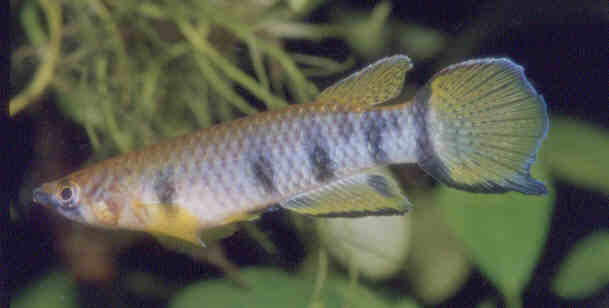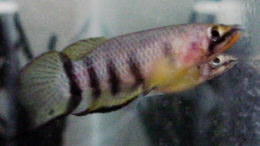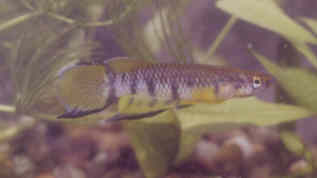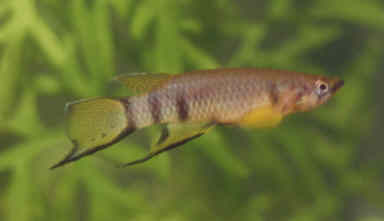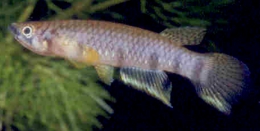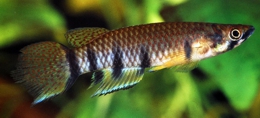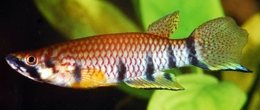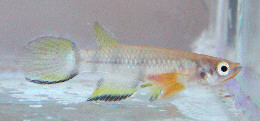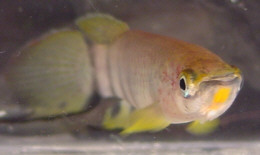Epiplatys dageti Poll 1953
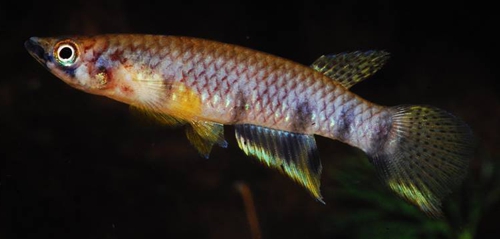
San Pedro
Photo courtesy of Ed Pürzl
| Meaning of Name |
After Professor Jacques Daget a French ichthyologist. |
||||||||||||
| First Description |
Poll M. 1953. Description de deux Cyprinodontidae nouveaux de la Cote d'Ivoire. Revue de Zoologie et de Botanique Africaines 48 (3-4): p 265-268, figure. |
||||||||||||
| Size |
5.5 cm |
||||||||||||
| Meristics |
|
||||||||||||
| Karyotype |
n = 25, A = 46 (Scheel 1990) |
||||||||||||
| Sub-Genus |
Epiplatys |
||||||||||||
| Group |
chaperi |
||||||||||||
| Synonyms |
|
||||||||||||
Populations
|
Monrovia - Formerly known as E.dageti monroviae. Collected by Stenholt Clausen in the summer of 1965.
San Pedro -
Tabou - This population did not have a red throat or any colouration in this area. This population soon died out in aquaria due to lack of colouration.
|
||||||||||||
| Type Locality |
Given as a swamp 18km from Abidjan (southern Ivory Coast) but no direction is shown. |
||||||||||||
| Distribution |
A coastal distribution from southwestern Liberia through into Ivory coast & western Ghana. http://homepage.uibk.ac.at/homepage/c102/c102mr/epiplaty/dageti.htm http://homepage.uibk.ac.at/homepage/c102/c102mr/epiplaty/monrovia.htm |
||||||||||||
| Habitat |
Coastal rainforest & mangrove swamps inhabiting small rivers, creeks & pools. |
||||||||||||
| Distinguishing Characteristics |
Fairly easy sp. to differenciate. Popoulations can differ in throat colouration, being yellow to orange to red. |
||||||||||||
| Colour/Pattern Variability | Fairly low. Differences occur in the thickness of the vertical barring which is generally thicker in more western populations. | ||||||||||||
| History |
Described by Peter's in 1863 from a single specimen from Liberia. This was described as Poecilia sexfasciata.The genus Lycocyprinus was erected in 1868 by Peters with this sp. as its type species. However, this name (sexfasciata) was already in use with Gill's description of Epiplatys sexfasciatus. Boulenger in 1915 & Myers in 1933 placed them as E.chaperi. Günther brought E.infrafaciatus into play suggesting they might represent jueveniles of this sp. The first live import into Germany was recorded in 1908 which originated from Monrovia, Liberia. A pair from this shipment were bought by Arnold but the remainder were sold on & subsequently lost. Arnold's fish spawned & he sent the original fish (preserved) to Boulenger in London who identified them as chaperi. Arnold did not agree with this identification & sent Boulenger a further pair but Boulenger did not change his identification. In 1952 (Autumn) Dr. L.Sheljuzhko of Germany collected fish for Werner of Munich. These collections were in the area of Abidjan, Ivory Coast & up to 50 miles north of this city. Fish were collected at Port Bouet & sent to Germany. Roloff sent material to Dr.M.Poll, Belgium who (in 1953) described them as E.dageti. This population lacked colour especially in the throat region & they quickly disappeared without any published article on them. Clausen collected them in the summer of 1962 in swamps at Awiebo in southwest Ghana & not far from the type locality. This population was noted as having no throat colouration. In the summer of 1963 sent Scheel live fish from a US import reportedly from 'Nigeria'. This was thought to represent a link between the Awiebo population & Arnold's chaperi. Arnold distributed them under Boulenger's chaperi identification & this strain was still in captivity until at least 1965. Daget & Arnoult considered they should be renamed & in 1964 described them as Epiplatys dageti monroviae. History of the synonym E.dageti monroviae Daget & Arnoult 1964. Information has been shown above, but
I have condensed the relevant pieces here for quick reference. Peters,
in 1863, gave the first report of individuals but described them as
Poecilia sexfasciata Peters 1863.
This name was preoccupied by Gill's earlier description. |
||||||||||||
| Breeding Notes |
An easy species to breed laying eggs in top & bottom mops. Water incubation takes around 11-14 days at 70°F with sexual maturity at around 5 months. Parents will eat young fry so taking the eggs out is the safer option. |
||||||||||||
| Diameter of Egg | |||||||||||||
| Remarks |
It has been noted in BKA newsletter NO. 86, October 1972 that soft water brings out the colours of this sp. whilst hard water produces the largest specimens. |
